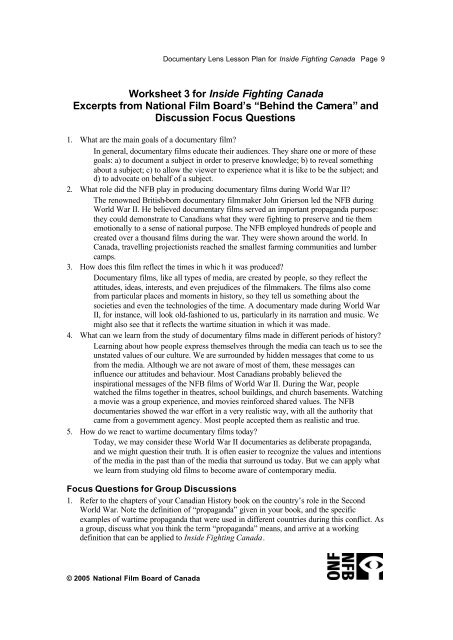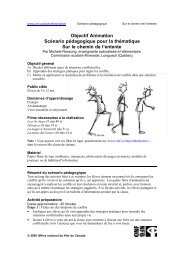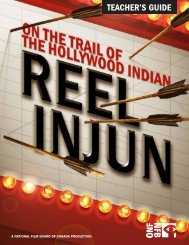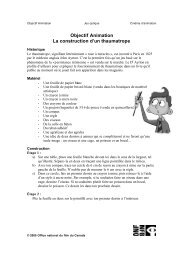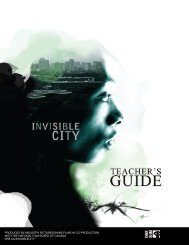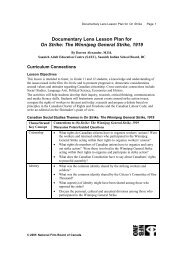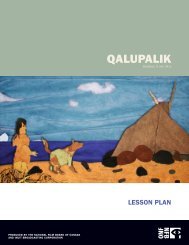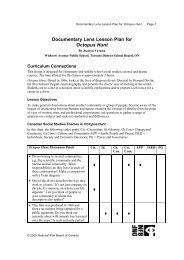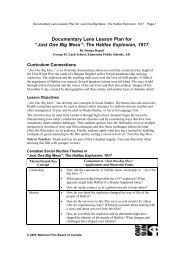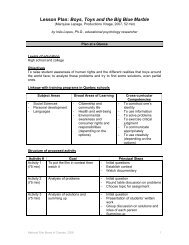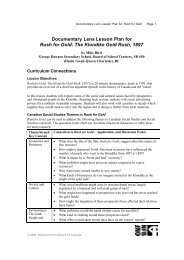Documentary Lens Lesson Plan for Inside Fighting Canada
Documentary Lens Lesson Plan for Inside Fighting Canada
Documentary Lens Lesson Plan for Inside Fighting Canada
- No tags were found...
Create successful ePaper yourself
Turn your PDF publications into a flip-book with our unique Google optimized e-Paper software.
<strong>Documentary</strong> <strong>Lens</strong> <strong>Lesson</strong> <strong>Plan</strong> <strong>for</strong> <strong>Inside</strong> <strong>Fighting</strong> <strong>Canada</strong> Page 9Worksheet 3 <strong>for</strong> <strong>Inside</strong> <strong>Fighting</strong> <strong>Canada</strong>Excerpts from National Film Board’s “Behind the Camera” andDiscussion Focus Questions1. What are the main goals of a documentary film?In general, documentary films educate their audiences. They share one or more of thesegoals: a) to document a subject in order to preserve knowledge; b) to reveal somethingabout a subject; c) to allow the viewer to experience what it is like to be the subject; andd) to advocate on behalf of a subject.2. What role did the NFB play in producing documentary films during World War II?The renowned British-born documentary filmmaker John Grierson led the NFB duringWorld War II. He believed documentary films served an important propaganda purpose:they could demonstrate to Canadians what they were fighting to preserve and tie thememotionally to a sense of national purpose. The NFB employed hundreds of people andcreated over a thousand films during the war. They were shown around the world. In<strong>Canada</strong>, travelling projectionists reached the smallest farming communities and lumbercamps.3. How does this film reflect the times in whic h it was produced?<strong>Documentary</strong> films, like all types of media, are created by people, so they reflect theattitudes, ideas, interests, and even prejudices of the filmmakers. The films also comefrom particular places and moments in history, so they tell us something about thesocieties and even the technologies of the time. A documentary made during World WarII, <strong>for</strong> instance, will look old-fashioned to us, particularly in its narration and music. Wemight also see that it reflects the wartime situation in which it was made.4. What can we learn from the study of documentary films made in different periods of history?Learning about how people express themselves through the media can teach us to see theunstated values of our culture. We are surrounded by hidden messages that come to usfrom the media. Although we are not aware of most of them, these messages caninfluence our attitudes and behaviour. Most Canadians probably believed theinspirational messages of the NFB films of World War II. During the War, peoplewatched the films together in theatres, school buildings, and church basements. Watchinga movie was a group experience, and movies rein<strong>for</strong>ced shared values. The NFBdocumentaries showed the war ef<strong>for</strong>t in a very realistic way, with all the authority thatcame from a government agency. Most people accepted them as realistic and true.5. How do we react to wartime documentary films today?Today, we may consider these World War II documentaries as deliberate propaganda,and we might question their truth. It is often easier to recognize the values and intentionsof the media in the past than of the media that surround us today. But we can apply whatwe learn from studying old films to become aware of contemporary media.Focus Questions <strong>for</strong> Group Discussions1. Refer to the chapters of your Canadian History book on the country’s role in the SecondWorld War. Note the definition of “propaganda” given in your book, and the specificexamples of wartime propaganda that were used in different countries during this conflict. Asa group, discuss what you think the term “propaganda” means, and arrive at a workingdefinition that can be applied to <strong>Inside</strong> <strong>Fighting</strong> <strong>Canada</strong>.© 2005 National Film Board of <strong>Canada</strong>


